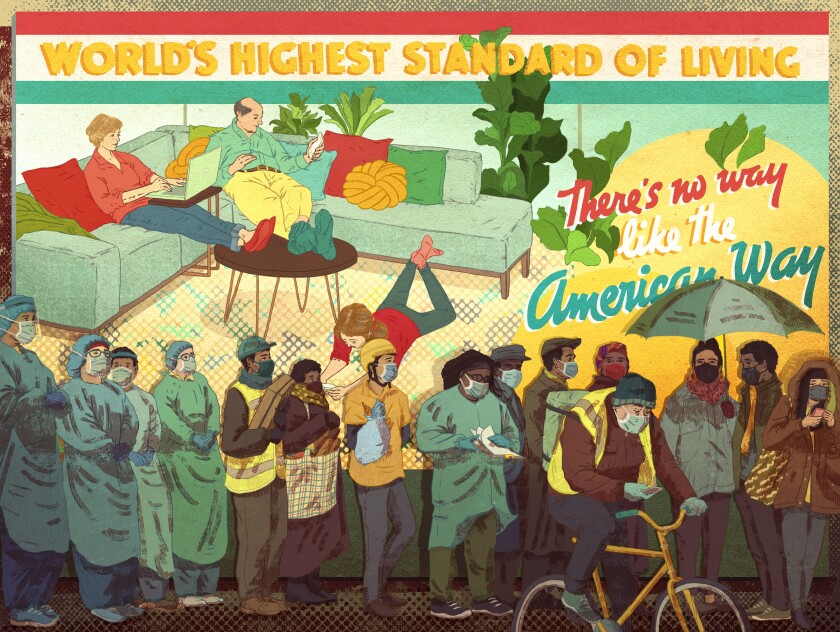The Great Tortilla Conspiracy and Chicano graphics
Because it’s awards season, I’ve been knee-deep in historian Mark Cousin’s 15-part doc “The Story of Film: An Odyssey” and it is thoughtful, informative and takes a refreshingly global perspective on cinema. I’m Carolina A. Miranda, arts and urban design columnist at the Los Angeles Times, with the week’s essential culture news and Washington dogfluencers:
The legacy of Chicano graphics

“Mujer de Mucha Enagua, PA’ TI XICANA,” 1999, by Yreina D. Cervántez collages images that reflect a range of artistic influences.
(Yreina D. Cervántez / SAAM)
Corn tortillas and edible ink.
Those were the highly unorthodox materials employed by a group of four Bay Area artists in the mid-2000s who called themselves the Great Tortilla Conspiracy and fabricated screen prints of venerated cultural figures such as Frida Kahlo and the Virgen de Guadalupe — prints that could then be devoured on the spot at public events.
These actions united the sacred with the profane: Symbols of Mexican-ness and Catholic ritual were delivered with heavy doses of dark humor. The artists — Jos Sances, Art Hazelwood, Río Yañez and Reñé Yañez (who died in 2018) — would turn up in lab coats to stage their absurdist communions, which were just as much performance art as they were innovative printmaking sessions. (The edible ink was a concoction of Hershey’s chocolate syrup and food coloring.)
Newsletter
Your essential guide to the arts in L.A.
Get Carolina A. Miranda’s weekly newsletter for what’s happening, plus openings, critics’ picks and more.
You may occasionally receive promotional content from the Los Angeles Times.
The work of the Great Tortilla Conspiracy figures in an exhibition of Chicano graphics at the Smithsonian American Art Museum in Washington, D.C. Like most things worth seeing at the moment, the exhibition, “¡Printing the Revolution! The Rise and Impact of Chicano Graphics, 1965 to Now,” is trapped in pandemic amber as the museum remains closed due to COVID-19.
Thankfully, there is a fat, beautifully illustrated catalog (344 pages; $49.95) that was published by Princeton University Press in December and is a worthwhile artistic endeavor on its own.

The catalog for “¡Printing the Revolution!” features the detail of an image created by Leonard Castellanos for L.A.’s Mechicano Art Center in 1977.
(Smithsonian American Art Museum)
Organized by E. Carmen Ramos, curator of Latinx art at SAAM, with curatorial assistant Claudia Zapata, the exhibition provides a needed reframing of Chicano graphics.
In fine art circles, Chicano printmaking has generally been dismissed as political agitprop connected to the civil rights movements of the 1960s and ‘70s, its aesthetic contributions minimized. As Ramos writes in the catalog’s introductory essay: “U.S. art history has yet to fully grasp Chicanx artists’ fluid negotiation of aesthetics and politics, and still largely places these artists in segregated tracks that rarely acknowledge their interconnectedness to the broad history of art.”
The exhibition and the catalog go a long way toward rectifying this. Essays by Ramos and Zapata, as well as scholars Terezita Romo and Tatiana Reinoza, collectively argue that Chicano printmaking was an important site of aesthetic innovation — one that has drawn inspiration from Pop, institutional critique, appropriation, conceptualism and internet art, as much as it has from political printmaking (where Mexican and Cuban revolutionary traditions loom large.)

“DDT,” 1969, by Bay Area Rupert García. With flat colors, García evoked the language of Pop.
(Rupert García / SAAM)
In addition, the catalog tracks the ways in which the influence of Chicano graphics have extended to other networks of artists.
Chicana artist Yreina D. Cevántez influenced Peruvian American artist Favianna Rodriguez, who helped co-found the printmaking collective Taller Tupac Amaru in the Bay Area. In L.A., the long-running community print studio, Self Help Graphics & Arts, has hosted artists from all over including Poli Marichal of Puerto Rico, and Sam Coronado, who hails from Texas. Coronado subsequently launched his own screenprint residency in Austin, Series Project, which has influenced others, including the Dominican American artist Pepe Coronado and the Ecuadorean American Sandra C. Fernández, whose work has explored the subject of Dreamers and immigration.
Best of all, the book features more than 100 full-color plates from the Smithsonian’s collection of Chicano graphics (which currently stands at more than 500 works). This includes several fold-out panels that feature richly hued Codex-style pieces by Enrique Chagoya and Eric J. Garcia.

Sonia Romero’s “Bee Pile,” 2010 fuses block printing with hand-sewn felt pieces.
(SAAM)
Particularly timely is a fold-out panel displaying an ongoing poster project by Bay Area artist Oree Originol that tracks victims of police violence. “The Justice for Our Lives” project, as the series is titled, consists of simple black-and-white portraits that readers can also download for free and paste-up.
On its own, the catalog is worthwhile for its timely reconsideration of the ways in which Chicano culture has shaped art and life in the U.S. Here’s hoping the show it accompanies can also be viewed.
Art and artists
Since we’re on the subject of Latino representation, this week I wrote about a beguiling new monograph by photographer Reynaldo Rivera that was just published by Semiotext(e). The book gathers Rivera’s images from the 1980s and early ‘90s when he was training his lens on L.A.’s polyglot Latino bohemia, capturing performance art happenings and drag shows in working-class bars. “To find things about Latinos, you have to read other people’s footnotes,” he tells me. “I wanted a book about us in L.A. where we are not the footnote.”

“Performer, Silverlake Lounge, 1995, by Reynaldo Rivera.
(Reynaldo Rivera)
The Times’ Deborah Vankin has a sit-down with L.A. artist Doug Aitken, who last year teamed up with L.A. Dance Project to create a film that engulfs the viewer. That work is now on view at Regen Projects, in the artist’s solo show “Flags and Debris.” Also on view are new collaged works made from scraps of Aitken’s old clothing, the first time the artist has worked with fabric — experimentation that was inspired by pandemic lockdowns. “I started looking around me,” he says. “I started making these personal challenges. And one of them was: How can you create with what’s immediately around you?”
Plays and players
Theater critic Charles McNulty is marinating in the work of playwright Adrienne Kennedy, who “provokes rapturous tributes from other writers,” but whose work is infrequently staged. Thankfully a couple of theater companies have stepped up: The Round House Theatre, in Bethesda, Md., in collaboration with the McCarter Theatre Center in Princeton, N.J., is staging a digital festival, “The Work of Adrienne Kennedy: Inspiration & Influence.” The works present an edifying experience, notes McNulty: “Kennedy reminds us that a play can also be a theatrical poem, that a drama can be divided into movements instead of acts and that circularity can do things linearity can’t even imagine.”

American playwright Adrienne Kennedy in 1967.
(Evening Standard / Hulton Archive / Getty Images)
Nathan Wolfe is a pandemic expert whose firm helps predicts outbreaks. Now he is the subject of a virtual solo show by playwright Lauren Gunderson titled “The Catastrophist,” a co-commission of the Bay Area’s Marin Theatre Company and the Round House Theatre. An interesting wrinkle: Gunderson and Wolfe are married. He is portrayed by an actor in the performance. But it is both their voices you hear in the performance, reports The Times’ Ashley Lee. “Even though I was being told about Wolfe’s career,” she writes, “it was Gunderson’s work itself that I experienced.”
Imagine a show staged online in which you cook a meal along with the principal performer as he performs a monologue. That’s the premise of “Bollywood Kitchen,” Sri Rao’s one-man show, currently airing on the Geffen Playhouse’s virtual platform. Culture reporter Jessica Gelt tuned in (and made some chicken curry in the process). “The resulting cross between the Food Network and live theater features careful food-centric cinematography intended to help viewers keep pace with the cooking, while still allowing Rao to lead a journey through his family history,” she writes.
Enjoying this newsletter? Consider subscribing to the Los Angeles Times
Your support helps us deliver the news that matters most. Become a subscriber.
Contributor Margaret Gray tuned in to a filmed version of Ryan J. Haddad’s autobiographical one-man show “Hi, Are You Single?,” a co-production of the Woolly Mammoth Theatre Company in Washington, D.C., and IAMA Theatre Company in L.A. The show explores Haddad’s adventures as a single man with cerebral palsy who is in perpetual search of a boyfriend. His anecdotes, she notes, “coalesce into a grim picture of society’s dehumanization of people with disabilities.”
Plus, The Times’ Julia Barajas explains why the filmed version of “Hamilton” earned Golden Globe nominations but will not be eligible for the Oscars.
My colleague Glenn Whipp, who covers film and all the ins and outs of awards season, is of the opinion that “Hamilton” is most definitely “not a movie.”
Memo to Biden
Last week, the Arts & Books team published a series of forward-looking pieces as the Biden-Harris administration takes the reins in Washington, D.C.
Culture critic Mary McNamara, says it’s time to get away from the reality show antics and get back to the business of governing. “That carefully edited and produced image of a tough-talking, rule-dismissing man of action, boosted by the incendiary power of Twitter, is exactly what tens of millions of Americans — having spent years under the spell of television’s ruthless cavalry of ‘antiheroes’ — believed we needed to script this country back into shape,” she writes. “And now we know how that turns out — with the most ignominious exit ever of an American president.”

“Life is not a movie,” writes Mary McNamara — after living through four years of a presidency that acted like it was.
(Edel Rodriguez / For The Times)
Times culture writer Daniel Hernandez notes that the Biden-Harris era will be historic in terms of representation, and that some of the administration’s initial moves — such as reaffirming a commitment to DACA — are “reassuring.” But, he notes, among Latinos, “wait-and-see is still the mood” since “Democratic-controlled governments offer a painful track record on reforms that could benefit Latino communities.”
I wrote a memo to the new administration about big city urbanism: “The Biden-Harris administration is contending with a pandemic that has made more stark the racial, social and economic inequities of our cities, be it access to housing, green spaces or functional transit options — at a moment in which hundreds of thousands of people teeter on the brink of eviction in California alone.” My advice for beginning to turn things around: treat housing like infrastructure, invest in multi-modal transit, and don’t forget to involve the designers from day one.
Plus, a group of mayors, including L.A. Mayor Eric Garcetti and San Francisco Mayor London Breed, are calling on the federal government to craft a response to the crisis in the arts induced by the pandemic.
Book editor Boris Kachka brought together Pulitzer Prize-winning playwright and novelist Ayad Akhtar, Pulitzer Prize-winning historian Annette Gordon-Reed, author David Kaye, Harvard Law School professor Martha Minow, author Jonathan Rauch and journalist and author Héctor Tobar to discuss how we might build a more stable democracy after the divisiveness that came to a head with the Jan. 6 insurrection.
And Heather John Fogarty finished her United We Read series — throughout the presidential election season she read a book from every state in the nation — on a humbled note. “What so many stories amplify across the nation, regardless of political ideologies,” she writes, “are inequities specific to our respective individual communities.”

Cat O’Neil’s illustration takes its cue from Margaret Bourke-White’s 1937 photo that juxtaposes American disparities.
(Cat O’Neil / For The Times)
Essential happenings
As always, Matt Cooper reliably rounds up all the things to do this week, including the L.A. Phil’s virtual star-studded gala which was filmed at the Hollywood Bowl and will premiere on Saturday at 6 p.m. Expect appearances from Julie Andrews, Natalie Portman, Katy Perry and, of course, musical director Gustavo Dudamel.
To his list I add a virtual exhibition of photography: Victoria Sambunaris is the recipient of this year’s Julius Shulman Institute Excellence in Photography Award. Through landscape photography, the artist tracks the ways in which large-scale industrial interventions make their mark on the land — be it petrochemical pipelines or global transportation networks or political markers (such as the border wall). But her work goes deeper than that, looking at the ways in which these space are shaped by man and time.

“Untitled (limestone quarry with Pilot’s Peak), West Wendover, Nevada,” 2004, by Victoria Sambunaris.
(Victoria Sambunaris)
Architect Barbara Bestor, executive director of the Julius Shulman Institute, has a good interview with the artist about her work, which you can read at this link, where you can also view the artist’s show.
Passages
Ricky Powell, a photographer who covered the early stars of hip-hop and was known as the “fourth Beastie Boy,” has died at 59.
Hal Holbrook, the screen and theater actor, known for his uncanny on-stage depiction of Mark Twain, is dead at 95.
Christopher Plummer, the debonair Canadian actor who played Capt. Von Trapp in the filmed version of “The Sound of Music,” and earned an Emmy, a Tony and an Academy Award in his 50-year career in film, television and the stage, has died at 91. “I’m so sorry for people who actually do want to retire,” he said in 2015, “it means that they haven’t loved what they do in life.”

Actor Christopher Plummer, right, on the set of Ridley Scott’s “All the Money in the World.”
(Giles Keyte / Sony Pictures)
In other news
— The U.S. Supreme Court has rejected two Nazi-era art restitution cases on the grounds that the cases could not be tried in U.S. courts.
— California Assemblyman James Ramos has introduced a measure to replace the statue of Junipero Serra, which represents California in the U.S. Capitol.
— How the cash-strapped Center Theatre Group raised more than $700,000 through a Zoom party.
— 18 L.A. arts groups are getting critical pandemic support grants from the Mike Kelley Foundation for the Arts.
— Thirty years after her killing, a painted memorial to Latasha Harlins, who was shot in 1991 by liquor store merchant Soon Ja Du, an event that, along with the beating of Rodney King, served as a spark of the ’92 uprisings — has finally materialized in South L.A.
— The city of Palm Springs has declined to sponsor the Desert X biennial over its ties to Saudi Arabia and is instead trying to contract with artists directly to create art installations.
— “We’ve commodified human displacement.” How artist David Taylor is using drones to document ICE detention centers.
— A new Senate bill includes $10 billion for cities that are considering removing urban freeways.
— Dallas Morning News architecture critic Mark Lamster has a must-read on the viral architecture documentary by Russian dissident Alexei Navalny, who exposes the “McMansion scaled up to palatial level” that Vladimir Putin has allegedly built for himself on the Black Sea.
— Sort of related: leaks and other engineering troubles at 432 Park, one of the wealthiest addresses in the world.
— Amazon’s proposed new HQ looks like a giant whirly.
— Gee’s Bend quilters are now on Etsy.
And last but not least …
Because I’m all about the prime dog content, a very important historic story about First Dogs.
*** This article has been archived for your research. The original version from Los Angeles Times can be found here ***


